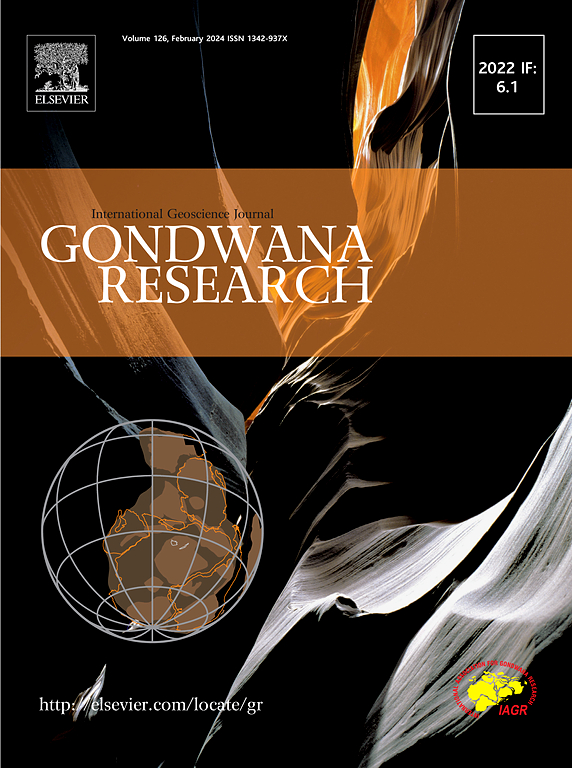Carboniferous-Permian magmatism in western section of the North Qaidam, northern Tibet Plateau: Response to the spatio-temporal evolution of the Paleo-Tethys Ocean
IF 7.2
1区 地球科学
Q1 GEOSCIENCES, MULTIDISCIPLINARY
引用次数: 0
Abstract
The origin of Late Paleozoic igneous rocks in the North Qaidam (NQ) remains controversial. This study presents comprehensive geochronological, geochemical, and isotopic data on the igneous rocks in western section of the NQ. The chronological results indicate that the Yanchangbeishan (YC) hornblende gabbro was formed at ca. 254 Ma; the Xiaosaishitengshan (XS) gabbro, biotite quartz-diorite, monzogranite, and andesite were formed at ca. 318 Ma, ca. 259 Ma, ca. 252 Ma, and ca. 271 Ma, respectively; and the Dasaishitengshan (DS) gabbro, tonalite, and biotite monzogranite were formed at ca. 268 Ma, ca. 272 Ma, and ca. 282 Ma, respectively. The Lu-Hf isotopic results show that the εHf(t) values of YC hornblende gabbro, XS andesite, and DS gabbro and tonalite are + 1.21 to + 9.53, +9.01 to + 15.70, +0.05 to + 4.71, and − 5.43 to − 1.93, respectively. Among them, XS gabbro (high-alumina) and andesite, and YC gabbro (high-magnesium) exhibit significant depletions in Nb, Ta, and Ti, similar to island arc magmas, which formed by partial melting of depleted lithospheric mantle metasomatized by slab fluids to varying degrees. DS gabbro (high-Nb) shows slight depletions in Nb, Ta, and Ti, resembling intraplate rift basic rocks, and resulting from low-degree partial melting of depleted mantle wedge metasomatized by slab melts. XS biotite quartz-diorite, monzogranite, and DS biotite monzogranite have high SiO2 (63.69–76.85 wt%) contents and low Mg# values (28–43), classified as I-type granites, formed by partial melting of juvenile crust. DS tonalite (high Ba-Sr) shows depletions in Nb, Ta, and Ti, originating from the lithospheric mantle metasomatized by slab-derived fluids and undergoing extensive fractional crystallization. By integrating the results of this study with published work regarding the igneous rocks in the NQ, we propose a new tectonic evolution model involving Zongwulong Paleo-Tethys Ocean subduction slab roll-back and subduction zone retreat for the Late Paleozoic in the NQ.

青藏高原北缘柴达木西段石炭-二叠系岩浆作用:对古特提斯洋时空演化的响应
柴达木北部晚古生代火成岩的成因一直存在争议。本文对北秦岭西段火成岩进行了全面的年代学、地球化学和同位素研究。年代学结果表明,盐场北山角闪石辉长岩形成于约254 Ma;小塞石腾山辉长岩、黑云母石英闪长岩、二长花岗岩和安山岩分别形成于约318 Ma、约259 Ma、约252 Ma和约271 Ma;大塞石腾山辉长岩、闪长岩和黑云母二长花岗岩分别形成于约268 Ma、约272 Ma和约282 Ma。Lu-Hf同位素结果表明,YC角闪长辉长岩、XS安山岩、DS辉长岩和闪长岩的εHf(t)值分别为+ 1.21 ~ + 9.53、+9.01 ~ + 15.70、+0.05 ~ + 4.71和- 5.43 ~ - 1.93。其中XS辉长岩(高铝)、安山岩和YC辉长岩(高镁)表现出Nb、Ta、Ti的明显消耗,类似于岛弧岩浆,是由不同程度的板岩流体交代的贫化岩石圈地幔部分熔融形成的。DS辉长岩(高Nb)表现出Nb、Ta、Ti的轻微亏缺,类似板内裂谷基性岩,是由板块熔体交代的亏缺地幔楔的低程度部分熔融所致。XS黑云母石英闪长岩、二长花岗岩和DS黑云母二长花岗岩SiO2含量高(63.69 ~ 76.85 wt%), Mg#值低(28 ~ 43),属于i型花岗岩,由幼壳部分熔融形成。DS型钠长石(高Ba-Sr)表现出Nb、Ta和Ti的消耗,源自岩石圈地幔被板块流体交代,并经历了广泛的分馏结晶。结合已发表的有关NQ火成岩的研究成果,提出了一种新的NQ晚古生代宗武龙-古特提斯洋俯冲板块回滚和俯冲带后退的构造演化模式。
本文章由计算机程序翻译,如有差异,请以英文原文为准。
求助全文
约1分钟内获得全文
求助全文
来源期刊

Gondwana Research
地学-地球科学综合
CiteScore
12.90
自引率
6.60%
发文量
298
审稿时长
65 days
期刊介绍:
Gondwana Research (GR) is an International Journal aimed to promote high quality research publications on all topics related to solid Earth, particularly with reference to the origin and evolution of continents, continental assemblies and their resources. GR is an "all earth science" journal with no restrictions on geological time, terrane or theme and covers a wide spectrum of topics in geosciences such as geology, geomorphology, palaeontology, structure, petrology, geochemistry, stable isotopes, geochronology, economic geology, exploration geology, engineering geology, geophysics, and environmental geology among other themes, and provides an appropriate forum to integrate studies from different disciplines and different terrains. In addition to regular articles and thematic issues, the journal invites high profile state-of-the-art reviews on thrust area topics for its column, ''GR FOCUS''. Focus articles include short biographies and photographs of the authors. Short articles (within ten printed pages) for rapid publication reporting important discoveries or innovative models of global interest will be considered under the category ''GR LETTERS''.
 求助内容:
求助内容: 应助结果提醒方式:
应助结果提醒方式:


